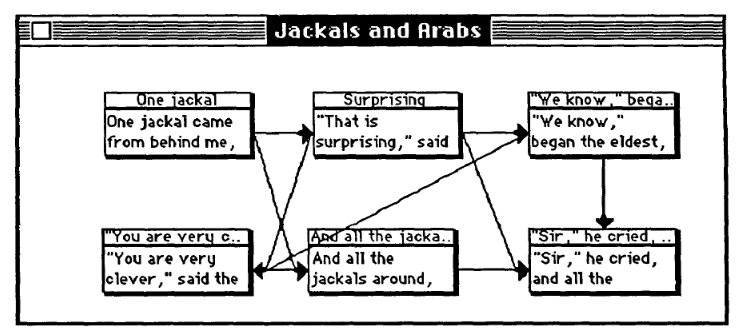| Type | JournalArticle |
|---|---|
| Date | 1987-11 |
| Tags | nonfiction, hypertext, Storyspace |
| Journal | HYPERTEXT '87: Proceedings of the ACM conference on Hypertext |
| Pages | 41--50 |
Hypertext and Creative Writing
The article spends a bit of time describing Storyspace, and even gives a screenshot (probably not a real screenshot, though?):

The authors try to position hypertext fiction along with other experimental literature:
Pound and Eliot set about to replace the narrative element in poetry with fragmented anecdotes or mythical paradigms. Joyce and Woolf called into question the strategy of the novel as a linear and objective narrative. They devised new ways of structuring their works based upon stream of consciousness (Woolf) or upon multiple layers of topical and mythical organization (Joyce). All of these writers were trying to set up new relationships between the moment-by-moment experience of reading a text and our perception of the organizing and controlling structures of the text.
A few more quotes:
Such a reader is like a mathematician who attempts to envision a four-dimensional object by looking at several projections in three dimensions: each projection is a snapshot, and all the snapshots must be synthesized to win a sense of the whole, if indeed such a sense is possible. The synthesis of many readings will be the ultimate experience that the electronic writing offers its readers.
Multiple reading does not necessarily mean multiple plots, although the most obvious way to construct a hypertextual fiction is by presenting the reader with choices that affect the plot. Hypertext could borrow from modern literature the techniques of stream of consciousness or multiple points of view as methods of organization.
All electronic literature takes the form of a game, a contest between author and reader. Unlike the static and monumental character of printed fiction, hypertextual fiction is characterized by impermanence and a lack of monumentality. A playful attitude prevails, as it should in any computing task. An interactive fiction is, after all, a program that the author creates and the reader executes, and any computer program can go unexpectedly and ridiculously off track.
Abstract
Among its many uses, hypertext can serve as a medium for a new kind of flexible, interactive fiction. Storyspace™ is a hypertext system we have created for authoring and reading such fiction. Interactive fiction in the computer medium is a continuation of the modern “tradition” of experimental literature in print. However, the computer frees both author and reader from restrictions imposed by the printed medium and therefore allows new experiments in literary structure.
| Name | Role |
|---|---|
| Jay David Bolter | Author |
| Michael Joyce | Author |